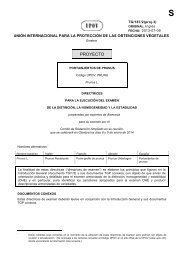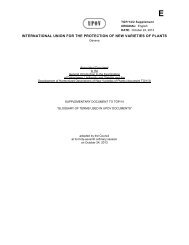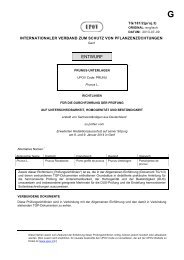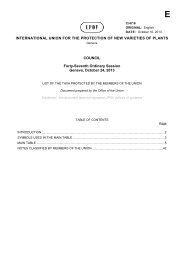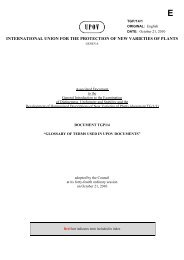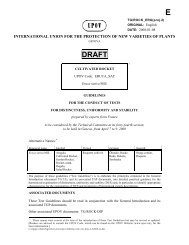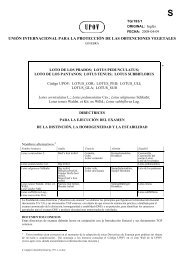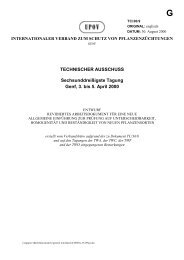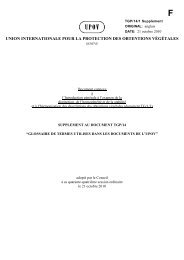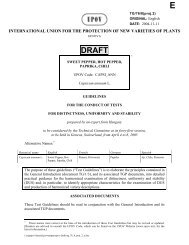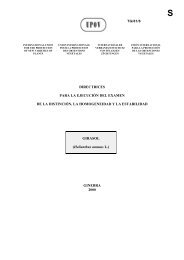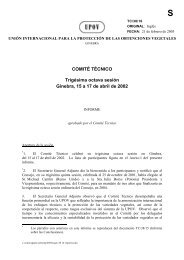Triticum aestivum L. emend. Fiori et Paol - International Union for the ...
Triticum aestivum L. emend. Fiori et Paol - International Union for the ...
Triticum aestivum L. emend. Fiori et Paol - International Union for the ...
You also want an ePaper? Increase the reach of your titles
YUMPU automatically turns print PDFs into web optimized ePapers that Google loves.
n:\orgupov\shared\tg\wheat_cd\upov_drafts\tg_3_12_proj_1.doc<br />
TG/3/12(proj.1)<br />
ORIGINAL: English<br />
DATE: 2012-04-03<br />
INTERNATIONAL UNION FOR THE PROTECTION OF NEW VARIETIES OF PLANTS<br />
Geneva<br />
Alternative Names: *<br />
DRAFT<br />
Wheat<br />
UPOV Code: TRITI_AES<br />
<strong>Triticum</strong> <strong>aestivum</strong> L. <strong>emend</strong>. <strong>Fiori</strong> <strong>et</strong> <strong>Paol</strong>.<br />
GUIDELINES<br />
FOR THE CONDUCT OF TESTS<br />
FOR DISTINCTNESS, UNIFORMITY AND STABILITY<br />
prepared by experts from France<br />
to be considered by <strong>the</strong><br />
Technical Working Party <strong>for</strong> Agricultural Crops<br />
at its <strong>for</strong>ty-first session, to be held in Angers, France, from May 21 to 25, 2012<br />
Botanical name English French German Spanish<br />
<strong>Triticum</strong> <strong>aestivum</strong> L.<br />
<strong>emend</strong>. <strong>Fiori</strong> <strong>et</strong> <strong>Paol</strong>.<br />
Wheat<br />
The purpose of <strong>the</strong>se guidelines (“Test Guidelines”) is to elaborate <strong>the</strong> principles contained in <strong>the</strong> General<br />
Introduction (document TG/1/3), and its associated TGP documents, into d<strong>et</strong>ailed practical guidance <strong>for</strong> <strong>the</strong><br />
harmonized examination of distinctness, uni<strong>for</strong>mity and stability (DUS) and, in particular, to identify<br />
appropriate characteristics <strong>for</strong> <strong>the</strong> examination of DUS and production of harmonized vari<strong>et</strong>y descriptions.<br />
ASSOCIATED DOCUMENTS<br />
These Test Guidelines should be read in conjunction with <strong>the</strong> General Introduction and its associated TGP<br />
documents.<br />
* These names were correct at <strong>the</strong> time of <strong>the</strong> introduction of <strong>the</strong>se Test Guidelines but may be revised or updated. [Readers<br />
are advised to consult <strong>the</strong> UPOV Code, which can be found on <strong>the</strong> UPOV Website (www.upov.int), <strong>for</strong> <strong>the</strong> latest in<strong>for</strong>mation.]<br />
*<br />
E
TG/3/12(proj.1)<br />
Wheat, 2012-04-03<br />
- 2 -<br />
TABLE OF CONTENTS PAGE<br />
1. SUBJECT OF THESE TEST GUIDELINES .................................................................................................................. 3<br />
2. MATERIAL REQUIRED................................................................................................................................................. 3<br />
3. METHOD OF EXAMINATION ....................................................................................................................................... 3<br />
3.1 NUMBER OF GROWING CYCLES ................................................................................................................................. 3<br />
3.2 TESTING PLACE ....................................................................................................................................................... 3<br />
3.3 CONDITIONS FOR CONDUCTING THE EXAMINATION ...................................................................................................... 3<br />
3.4 TEST DESIGN .......................................................................................................................................................... 3<br />
3.5 ADDITIONAL TESTS................................................................................................................................................... 4<br />
4. ASSESSMENT OF DISTINCTNESS, UNIFORMITY AND STABILITY ......................................................................... 4<br />
4.1 DISTINCTNESS ......................................................................................................................................................... 4<br />
4.2 UNIFORMITY ............................................................................................................................................................ 5<br />
4.3 STABILITY................................................................................................................................................................ 6<br />
5. GROUPING OF VARIETIES AND ORGANIZATION OF THE GROWING TRIAL......................................................... 6<br />
6. INTRODUCTION TO THE TABLE OF CHARACTERISTICS........................................................................................ 7<br />
6.1 CATEGORIES OF CHARACTERISTICS........................................................................................................................... 7<br />
6.2 STATES OF EXPRESSION AND CORRESPONDING NOTES............................................................................................... 7<br />
6.3 TYPES OF EXPRESSION ............................................................................................................................................ 7<br />
6.4 EXAMPLE VARIETIES ................................................................................................................................................ 8<br />
6.5 LEGEND .................................................................................................................................................................. 8<br />
7. TABLE OF CHARACTERISTICS/TABLEAU DES CARACTÈRES/MERKMALSTABELLE/TABLA DE<br />
CARACTERES.............................................................................................................................................................. 9<br />
8. EXPLANATIONS ON THE TABLE OF CHARACTERISTICS...................................................................................... 15<br />
8.1 EXPLANATIONS COVERING SEVERAL CHARACTERISTICS.............................................................................................. 15<br />
8.2 EXPLANATIONS FOR INDIVIDUAL CHARACTERISTICS .................................................................................................... 15<br />
8.3 THE DESCRIPTIONS OF THE GROWTH STAGES OF THE ZADOKS DECIMAL CODE FOR CEREALS .......................................... 23<br />
9. LITERATURE .............................................................................................................................................................. 24<br />
10. TECHNICAL QUESTIONNAIRE.................................................................................................................................. 25
1. Subject of <strong>the</strong>se Test Guidelines<br />
TG/3/12(proj.1)<br />
Wheat, 2012-04-03<br />
- 3 -<br />
These Test Guidelines apply to all vari<strong>et</strong>ies of <strong>Triticum</strong> <strong>aestivum</strong> L. <strong>emend</strong>. <strong>Fiori</strong> <strong>et</strong> <strong>Paol</strong>..<br />
2. Material Required<br />
2.1 The comp<strong>et</strong>ent authorities decide on <strong>the</strong> quantity and quality of <strong>the</strong> plant material required <strong>for</strong> testing<br />
<strong>the</strong> vari<strong>et</strong>y and when and where it is to be delivered. Applicants submitting material from a State o<strong>the</strong>r than<br />
that in which <strong>the</strong> testing takes place must ensure that all customs <strong>for</strong>malities and phytosanitary requirements<br />
are complied with.<br />
2.2 The material is to be supplied in <strong>the</strong> <strong>for</strong>m of seed.<br />
2.3 The minimum quantity of plant material, to be supplied by <strong>the</strong> applicant, should be:<br />
Seeds: 5 kg<br />
Ears (if requested): 100<br />
The seed should me<strong>et</strong> <strong>the</strong> minimum requirements <strong>for</strong> germination, species and analytical purity, health and<br />
moisture content, specified by <strong>the</strong> comp<strong>et</strong>ent authority. In cases where <strong>the</strong> seed is to be stored, <strong>the</strong><br />
germination capacity should be as high as possible and should, be stated by <strong>the</strong> applicant.<br />
If ear is requested, it should contain a sufficient number of viable seeds to establish a satisfactory row of<br />
plants <strong>for</strong> observation.<br />
2.4 The plant material supplied should be visibly healthy, not lacking in vigor, nor affected by any<br />
important pest or disease.<br />
2.5 The plant material should not have undergone any treatment which would affect <strong>the</strong> expression of<br />
<strong>the</strong> characteristics of <strong>the</strong> vari<strong>et</strong>y, unless <strong>the</strong> comp<strong>et</strong>ent authorities allow or request such treatment. If it has<br />
been treated, full d<strong>et</strong>ails of <strong>the</strong> treatment must be given.<br />
3. M<strong>et</strong>hod of Examination<br />
3.1 Number of Growing Cycles<br />
The minimum duration of tests should normally be two independent growing cycles.<br />
3.2 Testing Place<br />
Tests are normally conducted at one place. In <strong>the</strong> case of tests conducted at more than one place,<br />
guidance is provided in TGP/9 “Examining Distinctness”.<br />
3.3 Conditions <strong>for</strong> Conducting <strong>the</strong> Examination<br />
3.3.1 The tests should be carried out under conditions ensuring satisfactory growth <strong>for</strong> <strong>the</strong> expression of<br />
<strong>the</strong> relevant characteristics of <strong>the</strong> vari<strong>et</strong>y and <strong>for</strong> <strong>the</strong> conduct of <strong>the</strong> examination.<br />
3.3.2 Stage of development <strong>for</strong> <strong>the</strong> assessment<br />
The optimum stage of development <strong>for</strong> <strong>the</strong> assessment of each characteristic is indicated by a<br />
number in <strong>the</strong> second column of <strong>the</strong> Table of Characteristics. The stages of development denoted by each<br />
number are described in Chapter 8.3.<br />
3.4 Test Design<br />
3.4.1 Each test should be designed to result in a total of at least 2000 plants. The assessment <strong>for</strong> <strong>the</strong><br />
characteristics “Seasonal type” should be carried out on at least 300 plants.
TG/3/12(proj.1)<br />
Wheat, 2012-04-03<br />
- 4 -<br />
3.4.2 The design of <strong>the</strong> tests should be such that plants or parts of plants may be removed <strong>for</strong><br />
measurement or counting without prejudice to <strong>the</strong> observations which must be made up to <strong>the</strong> end of <strong>the</strong><br />
growing cycle.<br />
3.4.3 Single ear rows: if tests on ear rows are conducted, at least 100 ear rows should be observed.<br />
3.4.4 In case of hybrids, <strong>the</strong> parent lines have to be included in <strong>the</strong> test and should be tested and<br />
assessed as any o<strong>the</strong>r self-pollinating vari<strong>et</strong>y. The observations on <strong>the</strong> hybrid vari<strong>et</strong>y itself should be made<br />
on at least 200 plants.<br />
3.5 Additional Tests<br />
Additional tests, <strong>for</strong> examining relevant characteristics, may be established.<br />
4. Assessment of Distinctness, Uni<strong>for</strong>mity and Stability<br />
4.1 Distinctness<br />
4.1.1 General Recommendations<br />
It is of particular importance <strong>for</strong> users of <strong>the</strong>se Test Guidelines to consult <strong>the</strong> General Introduction<br />
prior to making decisions regarding distinctness. However, <strong>the</strong> following points are provided <strong>for</strong> elaboration<br />
or emphasis in <strong>the</strong>se Test Guidelines.<br />
To assess distinctness of hybrids, <strong>the</strong> parent lines and <strong>the</strong> <strong>for</strong>mula may be used according to <strong>the</strong> following<br />
recommendations:<br />
(i) description of parent lines according to <strong>the</strong> Test Guidelines;<br />
(ii) check of <strong>the</strong> originality of <strong>the</strong> parent lines in comparison with <strong>the</strong> vari<strong>et</strong>y collection, based on <strong>the</strong><br />
characteristics in Chapter 7, in order to identify similar parent lines;<br />
(iii) check of <strong>the</strong> originality of <strong>the</strong> hybrid <strong>for</strong>mula in relation to <strong>the</strong> hybrids in <strong>the</strong> vari<strong>et</strong>y collection,<br />
taking into account <strong>the</strong> most similar lines; and<br />
(iv) assessment of <strong>the</strong> distinctness at <strong>the</strong> hybrid level <strong>for</strong> vari<strong>et</strong>ies with a similar <strong>for</strong>mula.<br />
Fur<strong>the</strong>r guidance is provided in documents TGP/9 “Examining Distinctness” and TGP/8 “Trial Design and<br />
Techniques Used in <strong>the</strong> Examination of Distinctness, Uni<strong>for</strong>mity and Stability”.<br />
4.1.2 Consistent Differences<br />
The differences observed b<strong>et</strong>ween vari<strong>et</strong>ies may be so clear that more than one growing cycle is not<br />
necessary. In addition, in some circumstances, <strong>the</strong> influence of <strong>the</strong> environment is not such that more than a<br />
single growing cycle is required to provide assurance that <strong>the</strong> differences observed b<strong>et</strong>ween vari<strong>et</strong>ies are<br />
sufficiently consistent. One means of ensuring that a difference in a characteristic, observed in a growing<br />
trial, is sufficiently consistent is to examine <strong>the</strong> characteristic in at least two independent growing cycles.<br />
4.1.3 Clear Differences<br />
D<strong>et</strong>ermining wh<strong>et</strong>her a difference b<strong>et</strong>ween two vari<strong>et</strong>ies is clear depends on many factors, and<br />
should consider, in particular, <strong>the</strong> type of expression of <strong>the</strong> characteristic being examined, i.e. wh<strong>et</strong>her it is<br />
expressed in a qualitative, quantitative, or pseudo-qualitative manner. There<strong>for</strong>e, it is important that users of<br />
<strong>the</strong>se Test Guidelines are familiar with <strong>the</strong> recommendations contained in <strong>the</strong> General Introduction prior to<br />
making decisions regarding distinctness.<br />
4.1.4 Number of Plants / Parts of Plants to be Examined<br />
Unless o<strong>the</strong>rwise indicated, <strong>for</strong> <strong>the</strong> purposes of distinctness, all observations on single plants should<br />
be made on 20 plants or parts taken from each of 20 plants and any o<strong>the</strong>r observations made on all plants in
TG/3/12(proj.1)<br />
Wheat, 2012-04-03<br />
- 5 -<br />
<strong>the</strong> test, disregarding any off-type plants. In <strong>the</strong> case of observations of parts taken from single plants, <strong>the</strong><br />
number of parts to be taken from each of <strong>the</strong> plants should be 1.<br />
4.1.5 M<strong>et</strong>hod of Observation<br />
The recommended m<strong>et</strong>hod of observing <strong>the</strong> characteristic <strong>for</strong> <strong>the</strong> purposes of distinctness is<br />
indicated by <strong>the</strong> following key in <strong>the</strong> second column of <strong>the</strong> Table of Characteristics (see document TGP/9<br />
“Examining Distinctness”, Section 4 “Observation of characteristics”):<br />
MG: single measurement of a group of plants or parts of plants<br />
MS: measurement of a number of individual plants or parts of plants<br />
VG: visual assessment by a single observation of a group of plants or parts of plants<br />
VS: visual assessment by observation of individual plants or parts of plants<br />
Type of observation: visual (V) or measurement (M)<br />
“Visual” observation (V) is an observation made on <strong>the</strong> basis of <strong>the</strong> expert’s judgment. For <strong>the</strong><br />
purposes of this document, “visual” observation refers to <strong>the</strong> sensory observations of <strong>the</strong> experts<br />
and, <strong>the</strong>re<strong>for</strong>e, also includes smell, taste and touch. Visual observation includes observations<br />
where <strong>the</strong> expert uses reference points (e.g. diagrams, example vari<strong>et</strong>ies, side-by-side<br />
comparison) or non-linear charts (e.g. color charts). Measurement (M) is an objective<br />
observation against a calibrated, linear scale e.g. using a ruler, weighing scales, colorim<strong>et</strong>er,<br />
dates, counts, <strong>et</strong>c.<br />
Type of record: <strong>for</strong> a group of plants (G) or <strong>for</strong> single, individual plants (S)<br />
For <strong>the</strong> purposes of distinctness, observations may be recorded as a single record <strong>for</strong> a group of<br />
plants or parts of plants (G), or may be recorded as records <strong>for</strong> a number of single, individual<br />
plants or parts of plants (S). In most cases, “G” provides a single record per vari<strong>et</strong>y and it is not<br />
possible or necessary to apply statistical m<strong>et</strong>hods in a plant-by-plant analysis <strong>for</strong> <strong>the</strong> assessment<br />
of distinctness.”<br />
In cases where more than one m<strong>et</strong>hod of observing <strong>the</strong> characteristic is indicated in <strong>the</strong> Table of<br />
Characteristics (e.g. VG/MG), guidance on selecting an appropriate m<strong>et</strong>hod is provided in document TGP/9,<br />
Section 4.2.<br />
4.2 Uni<strong>for</strong>mity<br />
4.2.1 It is of particular importance <strong>for</strong> users of <strong>the</strong>se Test Guidelines to consult <strong>the</strong> General Introduction<br />
prior to making decisions regarding uni<strong>for</strong>mity. However, <strong>the</strong> following points are provided <strong>for</strong> elaboration or<br />
emphasis in <strong>the</strong>se Test Guidelines:<br />
4.2.2 Indication of sample size in <strong>the</strong> Table of Characteristics<br />
The recommended sample size <strong>for</strong> <strong>the</strong> assessment of uni<strong>for</strong>mity is indicated by <strong>the</strong> following key in<br />
<strong>the</strong> table of characteristics:<br />
A sample size of 100 plants/parts of plants/ear-rows<br />
B sample size of 2000 plants or parts of plants<br />
4.2.3 Uni<strong>for</strong>mity assessment on all plants in <strong>the</strong> test<br />
For <strong>the</strong> assessment of uni<strong>for</strong>mity in a sample of 2000 plants, a population standard of 0.3% and an<br />
acceptance probability of at least 95% should be applied. In <strong>the</strong> case of a sample size of 2000 plants, 10 offtypes<br />
are allowed.<br />
4.2.4 Uni<strong>for</strong>mity assessment on a sub-sample<br />
For <strong>the</strong> assessment of uni<strong>for</strong>mity in a sample of 100 ear-rows, plants or parts of plants, a population<br />
standard of 1% and an acceptance probability of at least 95% should be applied. In <strong>the</strong> case of a sample<br />
size of 100 ear-rows, plants or parts of plants, 3 off-types are allowed.
TG/3/12(proj.1)<br />
Wheat, 2012-04-03<br />
- 6 -<br />
An ear-row is considered to be an off-type ear-row if <strong>the</strong>re is more than 1 off-type plant within that ear-row.<br />
For “A” characteristics, with <strong>the</strong> exception of characteristic 1 and 2, <strong>the</strong> assessment of uni<strong>for</strong>mity can be<br />
done in 2 steps. In a first step, 20 plants are observed. If no off-types are observed, <strong>the</strong> vari<strong>et</strong>y is declared to<br />
be uni<strong>for</strong>m. If more than 3 off-types are observed, <strong>the</strong> vari<strong>et</strong>y is declared not to be uni<strong>for</strong>m. If 1 to 3 off-types<br />
are observed, an additional sample of 80 plants or parts of plants must be observed.<br />
4.2.6 Uni<strong>for</strong>mity assessment where <strong>the</strong> parent <strong>for</strong>mula is used<br />
Where <strong>the</strong> assessment of a hybrid vari<strong>et</strong>y involves <strong>the</strong> parent lines, <strong>the</strong> uni<strong>for</strong>mity of <strong>the</strong> hybrid<br />
vari<strong>et</strong>y should, in addition to an examination of <strong>the</strong> hybrid vari<strong>et</strong>y itself, also be assessed by examination of<br />
<strong>the</strong> uni<strong>for</strong>mity of its parent lines.<br />
For <strong>the</strong> assessment of uni<strong>for</strong>mity of hybrids, a population standard of 10% and an acceptance probability of<br />
at least 95% should be applied. In <strong>the</strong> case of a sample size of 200 plants, 27 off-types are allowed.<br />
4.3 Stability<br />
4.3.1 In practice, it is not usual to per<strong>for</strong>m tests of stability that produce results as certain as those of <strong>the</strong><br />
testing of distinctness and uni<strong>for</strong>mity. However, experience has demonstrated that, <strong>for</strong> many types of<br />
vari<strong>et</strong>y, when a vari<strong>et</strong>y has been shown to be uni<strong>for</strong>m, it can also be considered to be stable.<br />
4.3.2 Where appropriate, or in cases of doubt, stability may be fur<strong>the</strong>r examined by testing a new seed<br />
stock to ensure that it exhibits <strong>the</strong> same characteristics as those shown by <strong>the</strong> initial material supplied.<br />
4.3.3 Stability assessment: hybrid vari<strong>et</strong>ies<br />
Where appropriate, or in cases of doubt, <strong>the</strong> stability of a hybrid vari<strong>et</strong>y may, in addition to an<br />
examination of <strong>the</strong> hybrid vari<strong>et</strong>y itself, also be assessed by examination of <strong>the</strong> uni<strong>for</strong>mity and stability of its<br />
parent lines.<br />
5. Grouping of Vari<strong>et</strong>ies and Organization of <strong>the</strong> Growing Trial<br />
5.1 The selection of vari<strong>et</strong>ies of common knowledge to be grown in <strong>the</strong> trial with <strong>the</strong> candidate vari<strong>et</strong>ies<br />
and <strong>the</strong> way in which <strong>the</strong>se vari<strong>et</strong>ies are divided into groups to facilitate <strong>the</strong> assessment of distinctness are<br />
aided by <strong>the</strong> use of grouping characteristics.<br />
5.2 Grouping characteristics are those in which <strong>the</strong> documented states of expression, even where<br />
produced at different locations, can be used, ei<strong>the</strong>r individually or in combination with o<strong>the</strong>r such<br />
characteristics: (a) to select vari<strong>et</strong>ies of common knowledge that can be excluded from <strong>the</strong> growing trial<br />
used <strong>for</strong> examination of distinctness; and (b) to organize <strong>the</strong> growing trial so that similar vari<strong>et</strong>ies are<br />
grouped tog<strong>et</strong>her.<br />
5.3 The following have been agreed as useful grouping characteristics:<br />
(a) Straw: pith in cross section (characteristic 11)<br />
(b) Awns or scurs: presence (characteristic 15)<br />
(c) Ear: color (characteristic 17)<br />
(d) Seasonal type (characteristic 25)<br />
5.4 An alternative m<strong>et</strong>hod to grouping characteristics is GAIA m<strong>et</strong>hod. It has been developed to optimize<br />
trials, by avoiding <strong>the</strong> growing of some of <strong>the</strong> vari<strong>et</strong>ies in <strong>the</strong> vari<strong>et</strong>y collection. The principle is to compute a<br />
phenotypic distance b<strong>et</strong>ween each pair of vari<strong>et</strong>ies, this distance being a sum of distances on each individual<br />
observed characteristic. The background of <strong>the</strong> m<strong>et</strong>hod relies on <strong>the</strong> possibility given to <strong>the</strong> crop expert to<br />
express his confidence on <strong>the</strong> differences observed, by giving weights to <strong>the</strong> difference <strong>for</strong> each observed<br />
characteristic.<br />
GAIA m<strong>et</strong>hod is mainly used after a first growing cycle to identify those vari<strong>et</strong>ies in <strong>the</strong> vari<strong>et</strong>y collection<br />
which can be excluded from <strong>the</strong> subsequent growing cycle(s) because <strong>the</strong>y are “Distinct Plus” (see TGP/8/1<br />
Part II section 1.3.2.1) from all <strong>the</strong> candidate vari<strong>et</strong>ies. GAIA can also identify similar vari<strong>et</strong>ies, on which <strong>the</strong><br />
DUS examiner will need to focus attention in <strong>the</strong> subsequent growing cycle.
TG/3/12(proj.1)<br />
Wheat, 2012-04-03<br />
- 7 -<br />
5.5 Guidance <strong>for</strong> <strong>the</strong> use of grouping characteristics, in <strong>the</strong> process of examining distinctness, is<br />
provided through <strong>the</strong> General Introduction and document TGP/9 “Examining Distinctness”.<br />
6. Introduction to <strong>the</strong> Table of Characteristics<br />
6.1 Categories of Characteristics<br />
6.1.1 Standard Test Guidelines Characteristics<br />
Standard Test Guidelines characteristics are those which are approved by UPOV <strong>for</strong> examination of<br />
DUS and from which members of <strong>the</strong> <strong>Union</strong> can select those suitable <strong>for</strong> <strong>the</strong>ir particular circumstances.<br />
6.1.2 Asterisked Characteristics<br />
Asterisked characteristics (denoted by *) are those included in <strong>the</strong> Test Guidelines which are<br />
important <strong>for</strong> <strong>the</strong> international harmonization of vari<strong>et</strong>y descriptions and should always be examined <strong>for</strong> DUS<br />
and included in <strong>the</strong> vari<strong>et</strong>y description by all members of <strong>the</strong> <strong>Union</strong>, except when <strong>the</strong> state of expression of a<br />
preceding characteristic or regional environmental conditions render this inappropriate.<br />
6.2 States of Expression and Corresponding Notes<br />
6.2.1 States of expression are given <strong>for</strong> each characteristic to define <strong>the</strong> characteristic and to harmonize<br />
descriptions. Each state of expression is allocated a corresponding numerical note <strong>for</strong> ease of recording of<br />
data and <strong>for</strong> <strong>the</strong> production and exchange of <strong>the</strong> description.<br />
6.2.2 In <strong>the</strong> case of qualitative and pseudo-qualitative characteristics (see Chapter 6.3), all relevant states<br />
of expression are presented in <strong>the</strong> characteristic. However, in <strong>the</strong> case of quantitative characteristics with 5<br />
or more states, an abbreviated scale may be used to minimize <strong>the</strong> size of <strong>the</strong> Table of Characteristics. For<br />
example, in <strong>the</strong> case of a quantitative characteristic with 9 states, <strong>the</strong> presentation of states of expression in<br />
<strong>the</strong> Test Guidelines may be abbreviated as follows:<br />
State Note<br />
small 3<br />
medium 5<br />
large 7<br />
However, it should be noted that all of <strong>the</strong> following 9 states of expression exist to describe vari<strong>et</strong>ies and<br />
should be used as appropriate:<br />
State Note<br />
very small 1<br />
very small to small 2<br />
small 3<br />
small to medium 4<br />
medium 5<br />
medium to large 6<br />
large 7<br />
large to very large 8<br />
very large 9<br />
6.2.3 Fur<strong>the</strong>r explanation of <strong>the</strong> presentation of states of expression and notes is provided in document<br />
TGP/7 “Development of Test Guidelines”.<br />
6.3 Types of Expression<br />
An explanation of <strong>the</strong> types of expression of characteristics (qualitative, quantitative and<br />
pseudo-qualitative) is provided in <strong>the</strong> General Introduction.
6.4 Example Vari<strong>et</strong>ies<br />
TG/3/12(proj.1)<br />
Wheat, 2012-04-03<br />
- 8 -<br />
Where appropriate, example vari<strong>et</strong>ies are provided to clarify <strong>the</strong> states of expression of each<br />
characteristic.<br />
6.5 Legend<br />
(*) Asterisked characteristic – see Chapter 6.1.2<br />
QL Qualitative characteristic – see Chapter 6.3<br />
QN Quantitative characteristic – see Chapter 6.3<br />
PQ Pseudo-qualitative characteristic – see Chapter 6.3<br />
MG, MS, VG, VS – see Chapter 4.1.5<br />
A, B – see Chapter 4.2<br />
(a) See Explanations on <strong>the</strong> Table of Characteristics in Chapter 8.1.<br />
(+) See Explanations on <strong>the</strong> Table of Characteristics in Chapter 8.2.
1.<br />
(+)<br />
TG/3/12(proj.1)<br />
Wheat, 2012-04-03<br />
- 9 -<br />
7. Table of Characteristics/Tableau des caractères/Merkmalstabelle/Tabla de caracteres<br />
00<br />
VG<br />
English<br />
Seed: coloration with<br />
phenol<br />
français<br />
Semence : coloration<br />
au phenol<br />
deutsch<br />
Samen:<br />
Phenolfärbung<br />
español<br />
Semilla: color con<br />
phenol<br />
Example Vari<strong>et</strong>ies<br />
Exemples<br />
Beispielssorten<br />
Variedades ejemplo<br />
QN A none or very light Nulle ou très faible Fehlend oder sehr hell 1<br />
2.<br />
(+)<br />
09-11<br />
VG<br />
light Faible Hell claro Soissons 3<br />
medium moyenne mittel medio Aerobic 5<br />
dark Forte Dunkel Oscuro Excelcior 7<br />
very dark Très foncée Sehr dunkel Muy oscuro Sideral 9<br />
Coleoptile:<br />
anthocyanin<br />
coloration<br />
Coléoptile:<br />
pigmentation<br />
anthocyanique<br />
Keimscheide:<br />
Anthocyanfärbung<br />
QN A absent or very weak absente ou très faible fehlend oder sehr<br />
gering<br />
3.<br />
(*)<br />
(+)<br />
25-29<br />
VG<br />
Coleóptilo:<br />
pigmentación<br />
antociánica<br />
Note/<br />
Nota<br />
ausente o muy débil Altigo 1<br />
weak Faible Gering débil Accor 3<br />
medium Moyenne Mittel media Premio 5<br />
strong Forte Stark Fuerte Arezzo 7<br />
very strong Très <strong>for</strong>te Sehr stark Muy fuerte Caphorn 9<br />
Plant: growth habit Plante: port au tallage Pflanze: Wuchs<strong>for</strong>m Planta: porte<br />
QN B erect dressé aufrecht erecto Bandera 1<br />
4.<br />
(+)<br />
47-51<br />
VG<br />
semi erect demi-dressé halbaufrecht semierecto Esperia 3<br />
intermediate demi-dressé à<br />
demi-étalé<br />
mittel medio Crousty 5<br />
semi prostrate demi-étalé halbliegend semipostrado Euclide 7<br />
prostrate étalé liegend postrado Instinct 9<br />
Plant: frequency of<br />
plants with recurved<br />
flag leaves<br />
Plante : fréquence de<br />
plantes avec la<br />
dernière feuille<br />
r<strong>et</strong>ombante<br />
Pflanze: Häufigkeit<br />
von Pflanzen mit<br />
gebogenen obersten<br />
Blättern<br />
QN B absent or very low nulle ou très faible fehlend oder sehr<br />
gering<br />
Planta: frequencia de<br />
plantas con ¿<br />
ausente o muy débil Sorrial 1<br />
low faible gering débil Arezzo 3<br />
medium moyenne mittel media Courtot 5<br />
high <strong>for</strong>te stark fuerte Saturnus 7<br />
very high très <strong>for</strong>te sehr stark muy fuerte MV kolo 9
5.<br />
(*)<br />
(+)<br />
50-52<br />
MG<br />
English<br />
Time of ear<br />
emergence<br />
français<br />
TG/3/12(proj.1)<br />
Wheat, 2012-04-03<br />
- 10 -<br />
deutsch<br />
Époque d’épiaison Zeitpunkt des<br />
Ährenschiebens<br />
español<br />
Época de ¿<br />
Example Vari<strong>et</strong>ies<br />
Exemples<br />
Beispielssorten<br />
Variedades ejemplo<br />
QN B very early très précoce sehr früh muy temprana Accor 1<br />
6.<br />
(*)<br />
60-65<br />
VG<br />
early précoce früh temprana Caphorn 3<br />
medium moyenne mittel media Richepain 5<br />
late tardive spät tardía Boncap 7<br />
very late très tardive sehr spät muy tardía 9<br />
Flag leaf: glaucosity<br />
of sheath<br />
Dernière feuille :<br />
glaucescence de la<br />
gaine<br />
Oberstes Blatt:<br />
Bereifung der<br />
Blattscheide<br />
QN B absent or very weak absente ou très faible fehlend oder sehr<br />
gering<br />
7. 60-65<br />
VG<br />
Ultima hoja: ¿ de la<br />
vaina<br />
Note/<br />
Nota<br />
ausente o muy débil Benedict 1<br />
weak faible gering débil Aerobic 3<br />
medium moyenne mittel medio Pakito 5<br />
strong <strong>for</strong>te stark fuerte Solehio 7<br />
very strong très <strong>for</strong>te sehr stark muy fuerte Illico 9<br />
Flag leaf: glaucosity<br />
of blade (lower side)<br />
Dernière feuille :<br />
glaucescence du<br />
limbe (face inférieure)<br />
Oberste Blatt:<br />
Bereifung der<br />
Blattspreite<br />
QN B absent or very weak absente ou très faible fehlend oder sehr<br />
gering<br />
8.<br />
(*)<br />
60-69<br />
VG<br />
Ultima hoja: ¿ del<br />
limbo<br />
ausente o muy débil Courtot 1<br />
weak faible gering débil Bologna 3<br />
medium moyenne mittel medio Amador 5<br />
strong <strong>for</strong>te stark fuerte Cezanne 7<br />
very strong très <strong>for</strong>te sehr stark muy fuerte Goncourt 9<br />
Ear: glaucosity Epi : glaucescence Aehre: Bereifung ¿: ¿<br />
QN B absent or very weak absente ou très faible fehlend oder sehr<br />
gering<br />
ausente o muy débil Soissons 1<br />
weak faible gering débil Bologna 3<br />
medium moyenne mittel medio Solehio 5<br />
strong <strong>for</strong>te stark fuerte Premio 7<br />
very strong très <strong>for</strong>te sehr stark muy fuerte Exelcior 9
9. 60-69<br />
VG<br />
English<br />
Culm: glaucosity of<br />
neck<br />
français<br />
Tige : glaucescence<br />
du col de l’épi<br />
TG/3/12(proj.1)<br />
Wheat, 2012-04-03<br />
- 11 -<br />
deutsch<br />
Halme: Bereifung des<br />
obersten<br />
Internodiums<br />
QN B absent or very weak absente ou très faible fehlend oder sehr<br />
gering<br />
10.<br />
(*)<br />
(+)<br />
75-92<br />
MG<br />
español<br />
¿: ¿<br />
Example Vari<strong>et</strong>ies<br />
Exemples<br />
Beispielssorten<br />
Variedades ejemplo<br />
Note/<br />
Nota<br />
ausente o muy débil Benedict 1<br />
weak faible gering débil Saturnus 3<br />
medium moyenne mittel medio Aubusson 5<br />
strong <strong>for</strong>te stark fuerte Arezzo 7<br />
very strong très <strong>for</strong>te sehr stark muy fuerte Exelcior 9<br />
Plant: length Plante: longueur Pflanze: Lange Planta: altura (?)<br />
QN B very short très courte sehr niedrig muy corta Cordiale 1<br />
11.<br />
(+)<br />
80-92<br />
VG<br />
short courte niedrig corta Renan 3<br />
medium moyenne mittel media Intérêt 5<br />
long / tall longue / haute lang / hoch larga Bagatelle 007 7<br />
very long / very tall très longue / très haute sehr lang / sehr hoch muy larga 9<br />
Straw: pith in cross<br />
section<br />
Paille : moëlle en<br />
section transversale<br />
Halm: Füllung im<br />
Querschnitt<br />
Tallo: grosor<br />
PQ A absent or very thin Absente ou très mince fehlend oder sehr dünn Ausente o muy delgado Pakito 1<br />
12.<br />
(+)<br />
92<br />
VG<br />
medium moyenne mittel medio Saturnus 2<br />
very thick or filled Très épaisse ou pleine Sehr dick oder ? Muy grueso o ¿ Aerobic 3<br />
Ear: shape in profile Epi: <strong>for</strong>me en vue de<br />
profil<br />
Aehre : <strong>for</strong>m in<br />
Seiten-ansicht<br />
PQ B tapering Pyramidal Pyramiden-förmig Sankara 1<br />
fusi<strong>for</strong>m Fusi<strong>for</strong>me Spindle-förmig Arezzo 2<br />
parallel sided À bords parallèles Parallel Viscount 3<br />
semi clavate En demi-massue Halb keulenförmig Aura 4<br />
clavate En massue keulenförmig Apache 5
13.<br />
(*)<br />
(+)<br />
QN VG,B<br />
or<br />
MS,<br />
A<br />
14.<br />
(+)<br />
English<br />
français<br />
TG/3/12(proj.1)<br />
Wheat, 2012-04-03<br />
- 12 -<br />
deutsch<br />
80-92 Ear: density Epi: compacité Aehr: Dichte<br />
80-92<br />
VG<br />
español<br />
Example Vari<strong>et</strong>ies<br />
Exemples<br />
Beispielssorten<br />
Variedades ejemplo<br />
very lax Très lâche Sehr locker Magno 1<br />
lax Lâche Locker Sponsor 3<br />
medium Demi-lâche à demicompact<br />
Mittel Aubusson 5<br />
dense Compact Dicht Premio 7<br />
very dense Très compact Sehr dicht Rehti 9<br />
Ear: length Epi: longueur Aehre : länge<br />
QN very short Très court Sehr kurz 1<br />
15.<br />
(*)<br />
(+)<br />
B short Court Kurz Ambello 3<br />
80-92<br />
VG<br />
medium Moyen Mittel Soissons 5<br />
long Long Lang Aubusson 7<br />
very long Très long Sehr lang Folklor 9<br />
Awns or scurs:<br />
presence<br />
Barbes ou arêtes:<br />
présence<br />
QL B both absent Toutes les deux<br />
absentes<br />
16.<br />
(*)<br />
(+)<br />
80-92<br />
VG<br />
Grannen oder<br />
Spelzen-spitzen:<br />
Vorhandensein<br />
scurs present Arêtes présentes Spelzenspitzen<br />
vorhanden<br />
Beide fehlend Genoveva 1<br />
Note/<br />
Nota<br />
Aubusson 2<br />
awns present Barbes présentes Grannen vorhanden Arezzo 3<br />
Awns or scurs at tip<br />
of ear: length<br />
Barbes ou arêtes à<br />
l’extrémité de l’épi:<br />
longueur<br />
Grannen oder<br />
Spelzen-spitzen an<br />
der Aehrenspitze :<br />
länge<br />
QN B very short Très courtes Sehr kurz Ephoros 1<br />
short Courtes Kurz Graindor 3<br />
medium Moyennes Mittel Pakito 5<br />
long Longues Lang As de cœur 7<br />
very long Très longues Sehr lang Arezzo 9
17.<br />
(*)<br />
(+)<br />
English<br />
français<br />
TG/3/12(proj.1)<br />
Wheat, 2012-04-03<br />
- 13 -<br />
deutsch<br />
80-92 Ear: color Epi: couleur Aehre: Farbe<br />
español<br />
Example Vari<strong>et</strong>ies<br />
Exemples<br />
Beispielssorten<br />
Variedades ejemplo<br />
QL VG white Blanc Weiss Arezzo 1<br />
18.<br />
(+)<br />
B colored Coloré gefärbt Segor 2<br />
80-92<br />
VG<br />
Apical rachis<br />
segment: extend of<br />
hairiness of convex<br />
surface<br />
Article terminal du<br />
rachis: étendue de la<br />
pilosité de la face<br />
externe<br />
Oberstes<br />
Spindelglied : äussere<br />
Behaarung<br />
QN A absent or very weak Nulle ou très faible Fehlend oder sehr<br />
gering<br />
19.<br />
(+)<br />
80-92<br />
VG<br />
Note/<br />
Nota<br />
Graindor 1<br />
weak Faible Gering Crousty 3<br />
medium Moyenne Mittel Sirtaki 5<br />
strong Forte Stark Cadenza 7<br />
very strong Très <strong>for</strong>te Sehr stark KWS Scirocco 9<br />
Lower glume:<br />
shoulder width<br />
Glume inférieure:<br />
largeur de la<br />
troncature<br />
Hüllspelze : Schulterbreite<br />
QN A absent or very narrow Nulle ou très étroite Fehlend oder sehr<br />
schmal<br />
20.<br />
(+)<br />
Courtot 1<br />
(a) narrow Étroite Schmal Altigo 3<br />
80-92<br />
VG<br />
medium Moyenne Mittel Apache 5<br />
broad Large Breit Orvantis 7<br />
very broad Très large Sehr breit Aglika 9<br />
Lower glume:<br />
shoulder shape<br />
Glume inférieure:<br />
<strong>for</strong>me de la troncature<br />
Hüllspelze :<br />
chulter<strong>for</strong>m<br />
QN A sloping Inclinée Abfallend Ambello 1<br />
(a) slightly sloping Légèrement inclinée Leicht abfallend Soissons 3<br />
straight Droite Gerade Apache 5<br />
elevated Echancrée Gehoben Aubusson 7<br />
strongly elevated with<br />
2 nd point present<br />
Fortement échancrée<br />
avec présence d’un<br />
2ème bec<br />
Stark gehoben mit<br />
vorhandener zweiter<br />
spitze<br />
Fiorenzo 9
21.<br />
(+)<br />
80-92<br />
VG<br />
English<br />
Lower glume: beak<br />
length<br />
français<br />
Glume inférieure:<br />
longueur du bec<br />
TG/3/12(proj.1)<br />
Wheat, 2012-04-03<br />
- 14 -<br />
deutsch<br />
Hüllspelze :<br />
Zahnlänge<br />
español<br />
Example Vari<strong>et</strong>ies<br />
Exemples<br />
Beispielssorten<br />
Variedades ejemplo<br />
QN A very short Très court Sehr kurz Graindor 1<br />
22.<br />
(*)<br />
(+)<br />
(a) short Court Kurz Sollario 3<br />
80-92<br />
VG<br />
medium Moyen Mittel Quality 5<br />
long Long Lang Soissons 7<br />
very long Très long Sehr lang Bandera 9<br />
Lower glume: beak<br />
shape<br />
Glume inférieure:<br />
<strong>for</strong>me du bec<br />
Hüllspelze : zahn<strong>for</strong>m<br />
QN A straight Droit Gerade Premio 1<br />
23.<br />
(*)<br />
(+)<br />
(a) slightly curved Légèrement coudé Leicht gebogen Altigo 3<br />
80-92<br />
VG<br />
moderately curved Demi-coudé Mittel gebogen Sponsor 5<br />
strongly curved Fortement coudé Stark gebogen Quebon 7<br />
geniculate Genouillé geknickt Velocity<br />
Lower glume: extent<br />
of hairiness of<br />
internal surface<br />
Glume inférieure:<br />
étendue de la pilosité<br />
de la face interne<br />
Hüllspelze :<br />
verbreitung der<br />
inneren behaarung<br />
QN A weak Faible Gering Altigo 1<br />
24.<br />
(+)<br />
(a) medium Moyenne Mittel Alixan 3<br />
92<br />
VG<br />
strong Forte stark Quality 5<br />
Grain: color Graine: couleur Korn: farbe<br />
QL A white Blanc Weiss Recital 1<br />
25.<br />
(*)<br />
(+)<br />
-<br />
VG<br />
red Roux rot Apache 2<br />
Seasonal type Type de<br />
développement<br />
Wechselverhalten<br />
PQ winter type Type hiver Winter<strong>for</strong>m Aubusson 1<br />
alternative type Type alternatif Wechsel<strong>for</strong>m Cezanne 2<br />
spring type Type printemps sommer<strong>for</strong>m Josselin 3<br />
Note/<br />
Nota<br />
9
8. Explanations on <strong>the</strong> Table of Characteristics<br />
8.1 Explanations covering several characteristics<br />
TG/3/12(proj.1)<br />
Wheat, 2012-04-03<br />
- 15 -<br />
Characteristics containing <strong>the</strong> following key in <strong>the</strong> second column of <strong>the</strong> Table of Characteristics should be<br />
examined as indicated below:<br />
(a) Characteristics on lower glume must be observed at midthird of ear spikel<strong>et</strong>.<br />
8.2 Explanations <strong>for</strong> individual characteristics<br />
Ad. 1: Seed: coloration with phenol<br />
M<strong>et</strong>hod <strong>for</strong> D<strong>et</strong>ermination of Phenol Reaction<br />
Number of grains per test: 100 grains. The grains should not have been treated chemically<br />
Concentration of solution: 1 per cent Phenol-solution (freshly made up)<br />
Preparation of grains: Soak grains in phenol solution during 4 hours with a constant move. Rinse out<br />
4 or 5 times with clean water. Drain in half-light during at least 10 hours<br />
(reaction occurs in contact with air).<br />
Amount of solution: Whole grain surface must be in contact with phenol solution.<br />
Place: Laboratory<br />
Light: Half-light, out of direct sunshine<br />
Temperature: 15 to 25°C<br />
Time of recording: At least10 hours after rinsing<br />
Note: At least two of <strong>the</strong> example vari<strong>et</strong>ies should be included as a control<br />
1 3 5 7 9<br />
none or very light light medium dark very dark<br />
Ad. 2: Coleoptile: anthocyanin coloration<br />
M<strong>et</strong>hod <strong>for</strong> <strong>the</strong> D<strong>et</strong>ermination of Anthocyanin Coloration<br />
Number of grains per test: 100 grains<br />
Preparation of grains: S<strong>et</strong> up non-dormant grains on moistened filter paper covered with a P<strong>et</strong>ri dish<br />
lid during germination<br />
Place: Climate room with controlled temperature<br />
Light: Since <strong>the</strong> beginning of <strong>the</strong> test, 12h day / 12h night. Light intensity: 12000-<br />
15000 lux.<br />
Temperature: 19°C<br />
Time of recording: Coleoptiles fully developed (about 10 days) at stage 09-11<br />
Note: At least two of <strong>the</strong> example vari<strong>et</strong>ies should be included as a control when<br />
testing <strong>for</strong> distinctness
TG/3/12(proj.1)<br />
Wheat, 2012-04-03<br />
- 16 -<br />
1 3 5 7 9<br />
absent or very<br />
weak<br />
weak medium strong very strong<br />
Ad. 3: Plant: growth habit<br />
The growth habit should be assessed visually from <strong>the</strong> attitude of <strong>the</strong> leaves and tillers. The angle <strong>for</strong>med by<br />
<strong>the</strong> outer leaves and <strong>the</strong> tillers with an imaginary vertical axis should be used.<br />
1 3 5 7 9<br />
erect semi erect intermediate semi prostrate prostrate
TG/3/12(proj.1)<br />
Wheat, 2012-04-03<br />
- 17 -<br />
Ad. 4: Plant: frequency of plants with recurved flag leaves<br />
1 all flag leaves are rectilinear<br />
3 about 1/4 of <strong>the</strong> plants with recurved flag leaves<br />
5 about 1/2 of <strong>the</strong> plants with recurved flag leaves<br />
7 about 3/4 of <strong>the</strong> plants with recurved flag leaves<br />
9 all flag leaves are recurved<br />
1 3 5 7 9<br />
absent or very low low medium high very high<br />
Ad. 5: Time of ear emergence<br />
Time of ear emergence should be scored when <strong>the</strong> first spikel<strong>et</strong> is visible on 50% of ears.<br />
Ad. 10: Plant: length<br />
The length of plant includes stem, ear, awns and scurs.<br />
Ad. 11: Straw: pith in cross section<br />
Pith in cross section should be observed halfway b<strong>et</strong>ween base of ear and stem node below.<br />
1 2 3<br />
absent or very thin medium very thick or filled
Ad. 12: Ear: shape in profile<br />
TG/3/12(proj.1)<br />
Wheat, 2012-04-03<br />
- 18 -<br />
1 2 3 4 5<br />
tapering fusi<strong>for</strong>m parallel sided semi clavate clavate<br />
Ad. 13: Ear: density<br />
The density can be assessed ei<strong>the</strong>r visually or as measurement of <strong>the</strong> ratio of <strong>the</strong> number of spikel<strong>et</strong>s/ear<br />
length.<br />
1 3 5 7 9<br />
very lax lax medium dense very dense
Ad. 14: Ear: length<br />
TG/3/12(proj.1)<br />
Wheat, 2012-04-03<br />
- 19 -<br />
Length of ear should be observed excluding awns and scurs.<br />
1 3 5 7 9<br />
very short short medium long very long<br />
Ad. 15: Awns or scurs: presence<br />
1 2 3<br />
both absent scurs present awns present<br />
Ad. 16: Awns or scurs at tip of ear: length<br />
1 3 5 7 9<br />
very short short medium long very long
Ad. 17: Ear: color<br />
TG/3/12(proj.1)<br />
Wheat, 2012-04-03<br />
- 20 -<br />
1 2<br />
white colored<br />
Ad. 18: Apical rachis segment: extend of hairiness of convex surface<br />
1 3 5 7 9<br />
absent or very<br />
weak<br />
weak medium strong very strong<br />
Ad. 19: Lower glume: shoulder width<br />
1 3 5 7 9<br />
absent or very<br />
narrow<br />
narrow medium broad very broad
Ad. 20: Lower glume: shoulder shape<br />
TG/3/12(proj.1)<br />
Wheat, 2012-04-03<br />
- 21 -<br />
1 3 5 7 9<br />
strongly elevated<br />
sloping slightly sloping straight elevated with 2 nd point<br />
present<br />
Ad. 21: Lower glume: beak length<br />
1 3 5 7 9<br />
very short short medium long very long<br />
Ad. 22: Lower glume: beak shape<br />
1 3 5 7 9<br />
straight slightly curved<br />
moderately<br />
curved<br />
strongly curved geniculate
TG/3/12(proj.1)<br />
Wheat, 2012-04-03<br />
- 22 -<br />
Ad. 23: Lower glume: extent of hairiness of internal surface<br />
Ad. 24: Grain color<br />
Ad. 25: Seasonal type<br />
1 3 5<br />
weak medium strong<br />
1 2<br />
white red<br />
The seasonal type should be assessed on one or several plots sown in springtime. Example<br />
vari<strong>et</strong>ies should always be included in <strong>the</strong> plots. When <strong>the</strong> example vari<strong>et</strong>ies behave according to its<br />
description, <strong>the</strong> vari<strong>et</strong>ies under study can be described. At <strong>the</strong> time when <strong>the</strong> latest springtype vari<strong>et</strong>y<br />
is fully mature (stage 91/92 of <strong>the</strong> Zadoks decimal code), <strong>the</strong> growth stage reached by <strong>the</strong> respective<br />
vari<strong>et</strong>y should be assessed. The states of expression are defined as follows:<br />
Winter type: Winter type: <strong>the</strong> plants have reached stage 45 of <strong>the</strong> Zadoks decimal code (boots<br />
swollen) at maximum<br />
Alternative type: Alternative type: <strong>the</strong> plants have exceeded stage 45 of <strong>the</strong> Zadoks decimal code--as<br />
a rule <strong>the</strong>y have exceeded stage 75---and have reached stage 90 at maximum<br />
Spring type: Spring type: <strong>the</strong> plants have exceeded stage 90 of <strong>the</strong> Zadoks decimal code.
TG/3/12(proj.1)<br />
Wheat, 2012-04-03<br />
- 23 -<br />
8.3 The descriptions of <strong>the</strong> growth stages of <strong>the</strong> Zadoks decimal code <strong>for</strong> cereals<br />
Zadoks<br />
Decimal<br />
code<br />
Description<br />
00 Dry seed<br />
01 Start of imbibition<br />
03 Imbibition compl<strong>et</strong>e<br />
05 Radicle emerged from seed<br />
07 Coleoptile emerged from seed<br />
09 Leaf just at coleoptile tip<br />
10 First leaf through coleoptile<br />
11 First leaf unfolded<br />
12 2 leaves unfolded<br />
13 3 leaves unfolded<br />
14 4 leaves unfolded<br />
15 5 leaves unfolded<br />
16 6 leaves unfolded<br />
17 7 leaves unfolded<br />
18 8 leaves unfolded<br />
19 9 or more leaves unfolded<br />
20 Main shoot only<br />
21 Main shoot and 1 tiller<br />
22 Main shoot and 2 tillers<br />
23 Main shoot and 3 tillers<br />
24 Main shoot and 4 tillers<br />
25 Main shoot and 5 tillers<br />
26 Main shoot and 6 tillers<br />
27 Main shoot and 7 tillers<br />
28 Main shoot and 8 tillers<br />
29 Main shoot and 9 or more tillers<br />
30 Pseudo stem erection<br />
31 1st node d<strong>et</strong>ectable<br />
32 2nd node d<strong>et</strong>ectable<br />
33 3rd node d<strong>et</strong>ectable<br />
34 4th node d<strong>et</strong>ectable<br />
35 5th node d<strong>et</strong>ectable<br />
36 6th node d<strong>et</strong>ectable<br />
37 Flag leaf just visible<br />
39 Flag leaf ligule/collar just visible<br />
40 -<br />
41 Flag leaf sheath extending<br />
45 Boots just swollen<br />
47 Flag leaf sheath opening<br />
49 First awns visible<br />
50<br />
First spikel<strong>et</strong> of inflorescence<br />
visible<br />
53 1/4 of inflorescence emerged<br />
55 1/2 of inflorescence emerged<br />
57 3/4 of inflorescence emerged<br />
59<br />
Emergence of inflorescence<br />
compl<strong>et</strong>ed<br />
60 Beginning on an<strong>the</strong>sis<br />
65 An<strong>the</strong>sis half-way<br />
69 An<strong>the</strong>sis compl<strong>et</strong>ed<br />
70 -<br />
71 Kernel watery ripe<br />
73 Early milk<br />
75 Medium milk<br />
77 Late milk<br />
80 -<br />
83 Early dough<br />
85 Soft dough<br />
87 Hard dough<br />
90 -<br />
91<br />
Kernel hard (difficult to divide<br />
with thumbnail)<br />
92<br />
Kernel hard (no longer dented<br />
with thumbnail)<br />
93 Kernel loosening in daytime<br />
94<br />
Overripe, straw dead and<br />
collapsing<br />
95 Seed dormant<br />
96<br />
Viable seed giving 50%<br />
germination<br />
97 Seed not dormant<br />
98 Secondary dormancy induced<br />
99 Secondary dormancy lost
9. Literature<br />
TG/3/12(proj.1)<br />
Wheat, 2012-04-03<br />
- 24 -<br />
Bezar, H.J., Hadfield, P.D., 1982: Identification of New Zealand Wheat Cultivars. Crop Research Division,<br />
D.S.I.R., Christchurch, NZ<br />
Briggle, L.W., Reitz, L.P., 1963: Classification of <strong>Triticum</strong> Species and of Wheat Vari<strong>et</strong>ies Grown in <strong>the</strong><br />
United States. United States Department of Agriculture, Technical Bull<strong>et</strong>in No. 1278, US<br />
Bustarr<strong>et</strong>, J.,1944: Variétés <strong>et</strong> variations. Annales agronomiques, 14ème année, FR, pp. 336, pp. 365<br />
De Backer, A., 1983: L'homogénéité des variétés de Blé. Mémoire de fin d'études, 122e promotion<br />
Beauvais, FR<br />
Dhorne, D., 1985: Les cultivars de blé (<strong>Triticum</strong> spp) <strong>et</strong> leur identification. Mémoire pour l'obtention du titre<br />
d'Ingénieur D.P.E., Ecole Nationale Supérieure Agronomique de Toulouse, FR<br />
Feins, G.K. <strong>et</strong> al, 1975: Australian Wheat Vari<strong>et</strong>ies. CSIR Wheat Research Unit, North Rye, New South<br />
Wales, AU<br />
Friedberg, L. 1958<br />
Hervey-Murray, C.G., 1980: The Identification of Cereal Vari<strong>et</strong>ies. Cambridge University Press, GB<br />
Jonard, P., 1951: Les blés tendres (<strong>Triticum</strong> vulgare vill) cultivés en France. Institut National de la<br />
Recherche Agronomique, Paris, FR<br />
Milatz, R., 1970: Kriterien der G<strong>et</strong>reidearten einschliesslich Mais und ihre Bewertung zur<br />
Sortenidentifizierung. Verband Deutscher Pflanzenzüchter, Bonn, DE<br />
Percival, J., 1921: The Wheat Plant. monograph, Duckworth and Co., London, GB
10. Technical Questionnaire<br />
TECHNICAL QUESTIONNAIRE<br />
TG/3/12(proj.1)<br />
Wheat, 2012-04-03<br />
- 25 -<br />
Page {x} of {y}<br />
Reference Number:<br />
Application date:<br />
(not to be filled in by <strong>the</strong> applicant)<br />
TECHNICAL QUESTIONNAIRE<br />
to be compl<strong>et</strong>ed in connection with an application <strong>for</strong> plant breeders’ rights<br />
In <strong>the</strong> case of hybrid vari<strong>et</strong>ies which are <strong>the</strong> subject of an application <strong>for</strong> plant breeders’ rights, and where <strong>the</strong> parent<br />
lines are to be submitted as a part of <strong>the</strong> examination of <strong>the</strong> hybrid vari<strong>et</strong>y, this Technical Questionnaire should be<br />
compl<strong>et</strong>ed <strong>for</strong> each of <strong>the</strong> parent lines, in addition to being compl<strong>et</strong>ed <strong>for</strong> <strong>the</strong> hybrid vari<strong>et</strong>y.<br />
1. Subject of <strong>the</strong> Technical Questionnaire<br />
1.1 Botanical name <strong>Triticum</strong> <strong>aestivum</strong> L. <strong>emend</strong>. <strong>Fiori</strong> <strong>et</strong> <strong>Paol</strong>.<br />
1.2 Common name Wheat<br />
2. Applicant<br />
Name<br />
Address<br />
Telephone No.<br />
Fax No.<br />
E-mail address<br />
Breeder (if different from applicant)<br />
3. Proposed denomination and breeder’s reference<br />
Proposed denomination<br />
(if available)<br />
Breeder’s reference
TECHNICAL QUESTIONNAIRE<br />
TG/3/12(proj.1)<br />
Wheat, 2012-04-03<br />
- 26 -<br />
Page {x} of {y}<br />
# 4. In<strong>for</strong>mation on <strong>the</strong> breeding scheme and propagation of <strong>the</strong> vari<strong>et</strong>y<br />
4.1 Breeding scheme<br />
Vari<strong>et</strong>y resulting from:<br />
4.1.1 Crossing<br />
Reference Number:<br />
(a) controlled cross [ ]<br />
(please state parent vari<strong>et</strong>ies)<br />
(…………………..……………..…) x (……………..…………………..…)<br />
female parent male parent<br />
(b) partially known cross [ ]<br />
(please state known parent vari<strong>et</strong>y(ies))<br />
(…………………..……………..…) x (……………..…………………..…)<br />
female parent male parent<br />
(c) unknown cross [ ]<br />
4.1.2 Mutation [ ]<br />
(please state parent vari<strong>et</strong>y)<br />
4.1.3 Discovery and development [ ]<br />
(please state where and when discovered and how developed)<br />
4.1.4 O<strong>the</strong>r [ ]”<br />
(please provide d<strong>et</strong>ails)<br />
# Authorities may allow certain of this in<strong>for</strong>mation to be provided in a confidential section of <strong>the</strong> Technical Questionnaire.
TECHNICAL QUESTIONNAIRE<br />
4.2 M<strong>et</strong>hod of propagating <strong>the</strong> vari<strong>et</strong>y<br />
4.2.1 Seed-propagated vari<strong>et</strong>ies<br />
TG/3/12(proj.1)<br />
Wheat, 2012-04-03<br />
- 27 -<br />
Page {x} of {y}<br />
Reference Number:<br />
(a) Self-pollination [ ]<br />
(b) Hybrid [ ]<br />
(c) O<strong>the</strong>r<br />
(please provide d<strong>et</strong>ails)<br />
[ ]<br />
4.2.2 O<strong>the</strong>r [ ]”<br />
(please provide d<strong>et</strong>ails)<br />
In <strong>the</strong> case of hybrid vari<strong>et</strong>ies <strong>the</strong> production scheme <strong>for</strong> <strong>the</strong> hybrid should be provided on a separate she<strong>et</strong>. This<br />
should provide d<strong>et</strong>ails of all <strong>the</strong> parent lines required <strong>for</strong> propagating <strong>the</strong> hybrid e.g.<br />
Single Hybrid<br />
Three-Way Hybrid<br />
(…………………..……………..) x (……………..…………………..)<br />
female parent male parent<br />
(…………………..……………..) x (……………..…………………..)<br />
female line male line<br />
(……………..…………………..) x (……………..…………………..)<br />
single hybrid used as female parent male parent<br />
and should identify in particular:<br />
(a) any male sterile lines<br />
(b) maintenance system of male sterile lines.
TECHNICAL QUESTIONNAIRE<br />
TG/3/12(proj.1)<br />
Wheat, 2012-04-03<br />
- 28 -<br />
Page {x} of {y}<br />
Reference Number:<br />
5. Characteristics of <strong>the</strong> vari<strong>et</strong>y to be indicated (<strong>the</strong> number in brack<strong>et</strong>s refers to <strong>the</strong> corresponding<br />
characteristic in Test Guidelines; please mark <strong>the</strong> note which best corresponds).<br />
5.1<br />
(25)<br />
5.2<br />
(5)<br />
5.3<br />
(10)<br />
Characteristics Example Vari<strong>et</strong>ies Note<br />
Seasonal type<br />
winter type Aubusson 1[ ]<br />
alternative type Cezanne 2[ ]<br />
spring type Josselin 3[ ]<br />
Time of ear emergence<br />
very early Accor 1[ ]<br />
very early to early 2[ ]<br />
early Caphorn 3[ ]<br />
early to medium 4[ ]<br />
medium Richepain 5[ ]<br />
medium to late 6[ ]<br />
late Boncap 7[ ]<br />
late to very late 8[ ]<br />
very late 9[ ]<br />
Plant: length<br />
very short Cordiale 1[ ]<br />
very short to short 2[ ]<br />
short Renan 3[ ]<br />
short to medium 4[ ]<br />
medium Intérêt 5[ ]<br />
medium to long / tall 6[ ]<br />
long / tall Bagatelle 007 7[ ]<br />
long /tall to very long / very tall 8[ ]<br />
very long / very tall 9[ ]
TECHNICAL QUESTIONNAIRE<br />
5.4<br />
(11)<br />
5.5<br />
(15)<br />
5.6<br />
(17)<br />
TG/3/12(proj.1)<br />
Wheat, 2012-04-03<br />
- 29 -<br />
Page {x} of {y}<br />
Reference Number:<br />
Characteristics Example Vari<strong>et</strong>ies Note<br />
Straw: pith in cross section<br />
absent or very thin Pakito 1[ ]<br />
medium Saturnus 2[ ]<br />
very thick or filled Aerobic 3[ ]<br />
Awns or scurs: presence<br />
both absent Genoveva 1[ ]<br />
scurs present Aubusson 2[ ]<br />
awns present Arezzo 3[ ]<br />
Ear: color<br />
white Arezzo 1[ ]<br />
colored Segor 2[ ]
TECHNICAL QUESTIONNAIRE<br />
TG/3/12(proj.1)<br />
Wheat, 2012-04-03<br />
- 30 -<br />
Page {x} of {y}<br />
6. Similar vari<strong>et</strong>ies and differences from <strong>the</strong>se vari<strong>et</strong>ies<br />
Reference Number:<br />
Please use <strong>the</strong> following table and box <strong>for</strong> comments to provide in<strong>for</strong>mation on how your candidate vari<strong>et</strong>y differs<br />
from <strong>the</strong> vari<strong>et</strong>y (or vari<strong>et</strong>ies) which, to <strong>the</strong> best of your knowledge, is (or are) most similar. This in<strong>for</strong>mation may<br />
help <strong>the</strong> examination authority to conduct its examination of distinctness in a more efficient way.<br />
Denomination(s) of<br />
vari<strong>et</strong>y(ies) similar to your<br />
candidate vari<strong>et</strong>y<br />
Comments:<br />
Characteristic(s) in which<br />
your candidate vari<strong>et</strong>y differs<br />
from <strong>the</strong> similar vari<strong>et</strong>y(ies)<br />
Coleoptile: anthocyanin<br />
coloration<br />
Describe <strong>the</strong> expression of<br />
<strong>the</strong> characteristic(s) <strong>for</strong> <strong>the</strong><br />
similar vari<strong>et</strong>y(ies)<br />
Describe <strong>the</strong> expression of<br />
<strong>the</strong> characteristic(s) <strong>for</strong><br />
your candidate vari<strong>et</strong>y<br />
9 6
TECHNICAL QUESTIONNAIRE<br />
TG/3/12(proj.1)<br />
Wheat, 2012-04-03<br />
- 31 -<br />
Page {x} of {y}<br />
# 7. Additional in<strong>for</strong>mation which may help in <strong>the</strong> examination of <strong>the</strong> vari<strong>et</strong>y<br />
Reference Number:<br />
7.1 In addition to <strong>the</strong> in<strong>for</strong>mation provided in sections 5 and 6, are <strong>the</strong>re any additional characteristics which may<br />
help to distinguish <strong>the</strong> vari<strong>et</strong>y?<br />
Yes [ ] No [ ]<br />
(If yes, please provide d<strong>et</strong>ails)<br />
7.2 Are <strong>the</strong>re any special conditions <strong>for</strong> growing <strong>the</strong> vari<strong>et</strong>y or conducting <strong>the</strong> examination?<br />
Yes [ ] No [ ]<br />
(If yes, please provide d<strong>et</strong>ails)<br />
7.3 O<strong>the</strong>r in<strong>for</strong>mation<br />
A representative color image of <strong>the</strong> vari<strong>et</strong>y should accompany <strong>the</strong> Technical Questionnaire.<br />
8. Authorization <strong>for</strong> release<br />
(a) Does <strong>the</strong> vari<strong>et</strong>y require prior authorization <strong>for</strong> release under legislation concerning <strong>the</strong> protection of<br />
<strong>the</strong> environment, human and animal health?<br />
Yes [ ] No [ ]<br />
(b) Has such authorization been obtained?<br />
Yes [ ] No [ ]<br />
If <strong>the</strong> answer to (b) is yes, please attach a copy of <strong>the</strong> authorization.<br />
# Authorities may allow certain of this in<strong>for</strong>mation to be provided in a confidential section of <strong>the</strong> Technical Questionnaire.
TECHNICAL QUESTIONNAIRE<br />
TG/3/12(proj.1)<br />
Wheat, 2012-04-03<br />
- 32 -<br />
Page {x} of {y}<br />
9. In<strong>for</strong>mation on plant material to be examined or submitted <strong>for</strong> examination.<br />
Reference Number:<br />
9.1 The expression of a characteristic or several characteristics of a vari<strong>et</strong>y may be affected by factors, such as<br />
pests and disease, chemical treatment (e.g. growth r<strong>et</strong>ardants or pesticides), effects of tissue culture, different<br />
rootstocks, scions taken from different growth phases of a tree, <strong>et</strong>c.<br />
9.2 The plant material should not have undergone any treatment which would affect <strong>the</strong> expression of <strong>the</strong><br />
characteristics of <strong>the</strong> vari<strong>et</strong>y, unless <strong>the</strong> comp<strong>et</strong>ent authorities allow or request such treatment. If <strong>the</strong> plant material<br />
has undergone such treatment, full d<strong>et</strong>ails of <strong>the</strong> treatment must be given. In this respect, please indicate below, to<br />
<strong>the</strong> best of your knowledge, if <strong>the</strong> plant material to be examined has been subjected to:<br />
(a) Microorganisms (e.g. virus, bacteria, phytoplasma) Yes [ ] No [ ]<br />
(b) Chemical treatment (e.g. growth r<strong>et</strong>ardant, pesticide) Yes [ ] No [ ]<br />
(c) Tissue culture Yes [ ] No [ ]<br />
(d) O<strong>the</strong>r factors Yes [ ] No [ ]<br />
Please provide d<strong>et</strong>ails <strong>for</strong> where you have indicated “yes”.<br />
……………………………………………………………<br />
10. I hereby declare that, to <strong>the</strong> best of my knowledge, <strong>the</strong> in<strong>for</strong>mation provided in this <strong>for</strong>m is correct:<br />
Applicant’s name<br />
Signature Date<br />
[End of document]



